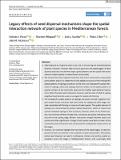Por favor, use este identificador para citar o enlazar a este item:
http://hdl.handle.net/10261/249383COMPARTIR / EXPORTAR:
 SHARE SHARE
 CORE
BASE CORE
BASE
|
|
| Visualizar otros formatos: MARC | Dublin Core | RDF | ORE | MODS | METS | DIDL | DATACITE | |

| Título: | Legacy effects of seed dispersal mechanisms shape the spatial interaction network of plant species in Mediterranean forests |
Autor: | Perea, Antonio J. CSIC ORCID; Wiegand, Throsten; Garrido, José L. CSIC ORCID; Rey, Pedro J.; Alcántara, Julio M. | Palabras clave: | Coexistence mechanisms Community-assembly Forest dynamics Plant-facilitation Point pattern analysis Recruitment networks Spatial self-thinning Species interactions |
Fecha de publicación: | 2021 | Editor: | British Ecological Society | Citación: | Journal of Ecology, (2021) | Resumen: | Seed dispersal by frugivores plays a key role in structuring and maintaining tree diversity in forests. However, little is known about how the spatial legacy of seed dispersal and early recruitment shapes spatial patterns and the spatial interaction network of plant species in mature forest communities. We analysed two fully mapped mixed Pine–Oak forest communities using spatial point pattern analysis to determine (a) the detailed structure of the intraspecific spatial patterns of saplings and adults, (b) the intra- and interspecific spatial interaction of saplings, adults and saplings relative to adults, (c) the spatial patterns of species richness at the community level and (d) whether seed dispersal mechanisms affect the plant–plant interaction networks and the ratio of adult to sapling neighbourhood densities used as surrogate for spatial self-thinning. The intraspecific spatial patterns of saplings and adults showed in general complex nested cluster structures that were similar for sapling and adult stages, despite substantial self-thinning in some dry-fruited species. The spatial network of saplings was characterized by positive spatial interactions. Adults of several tree species facilitated saplings in their proximity; however, adults of dry-fruited species, but not those of fleshy-fruited ones, lost almost all positive interactions that occurred at the sapling stage. Besides, interaction strength between adults was positive and often significantly stronger if both species were fleshy-fruited. At the community level, the forests were structured into multispecies clumps across all life stages. Synthesis. Our analyses highlight the importance of the spatial legacy of seed dispersal and early recruitment in the assembly of plant communities. Particularly, animal seed dispersal can lead to multispecies clusters and positive spatial associations across life stages in Mediterranean forests, with surprisingly little signatures of negative interactions. Our analysis suggests that changes of the spatial structure across plant life stages are driven by seed dispersal mechanisms and subsequent spatial self-thinning, generating a spatial footprint at the sapling stage that conditions the long-term interactions between adult plants. Combining spatial point pattern analysis with network analysis and species traits is a promising way to disentangle the processes underlying observed patterns of local diversity. | Versión del editor: | https://doi.org/10.1111/1365-2745.13744 | URI: | http://hdl.handle.net/10261/249383 | DOI: | 10.1111/1365-2745.13744 |
| Aparece en las colecciones: | (EBD) Artículos (EEZ) Artículos |
Ficheros en este ítem:
| Fichero | Descripción | Tamaño | Formato | |
|---|---|---|---|---|
| Perea.pdf | 1,37 MB | Adobe PDF |  Visualizar/Abrir |
CORE Recommender
SCOPUSTM
Citations
15
checked on 12-abr-2024
WEB OF SCIENCETM
Citations
14
checked on 23-feb-2024
Page view(s)
71
checked on 18-abr-2024
Download(s)
95
checked on 18-abr-2024
Google ScholarTM
Check
Altmetric
Altmetric
NOTA: Los ítems de Digital.CSIC están protegidos por copyright, con todos los derechos reservados, a menos que se indique lo contrario.
